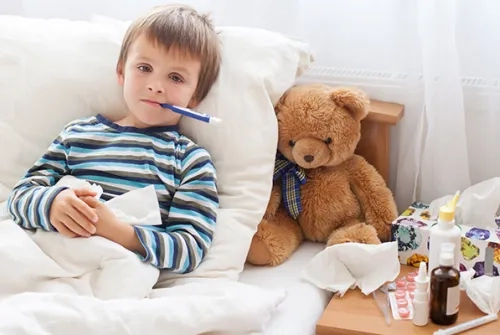Alo Yeditepe
Alo Yeditepe
High Fever in Children
What should the temperature be in infants and children? What are the ways to lower fever?
Fever is a common finding in infants and children, manifested by the body against various diseases. All babies get a fever from time to time. So, what should the fever be in babies and children? What are the ways to reduce a fever? Yeditepe University Kozyatağı Hospital Pediatric Health and Diseases / Newborn Specialist Prof. Dr. Filiz Bakar answered the questions about fever in babies and children.
Under normal conditions, how many degrees should the minimum and maximum fever be?
Normal body temperature is between 36.5-37.5 and is considered to be 37 degrees on average. Body temperature varies according to age, activity level, and time of day. Infants have a higher body temperature than older children and adults. The average body temperature in newborns is 37.5 degrees. While the body temperature is lower in the morning hours, it is 0.5 degrees higher in the evening.
What are the minimum and maximum body temperature under normal conditions?
A fever above 38 degrees in infants (up to 36 months) and 37.8 degrees in older children is considered a fever. Very hot environments or dressing the child in thick clothes can temporarily increase the body temperature, especially in infants. However, if the fever does not decrease when the temperature is lowered or the child's clothing is lightened, it may be a true fever.
How to measure fever in children?
Fever can be measured from the mouth, forehead, ear canal, armpit, and rectum. Rectal measurement is a method that is not used much in practice because it disturbs the child. Armpit measurement in infants and ear canal measurement in slightly older children are the most preferred and recommended methods by physicians.
In which cases should the hospital be consulted because of high fever?
If there is a fever in babies under the age of three, it is absolutely necessary to consult the hospital. Parents should take the child to the hospital urgently if there is persistent fever in older children if it rises at frequent intervals, and if it is accompanied by weakness, general condition disorder, vomiting, headache, diarrhea, cough, shortness of breath, rash, swelling in the joints and loss of consciousness. Resistant fever, especially lasting longer than 3 days, is an indication of a serious condition and it is necessary to consult the hospital.
How do we know if our child has covid or influenza? Does the fever increase in both?
Upper respiratory tract infections such as influenza, cold, and tonsil infection are the number one cause of fever in childhood. The most common symptoms of both influenza and Covid are sore throat, tickle in the throat, dry cough, muscle, and joint pain, loss of appetite, high fever, abdominal pain, and diarrhea. It is not possible to distinguish between influenza and Covid-19 on the basis of clinical symptoms, and it is not easy to distinguish between patients who apply to the hospital by questioning and examination. However, it can be detected by PCR testing.
How to lower high fever in children? How should home care be before consulting a doctor?
Fever is not a disease. It is an important clinical manifestation of infectious diseases. Therefore, the first step in the treatment of fever is to identify the cause and start treatment for it. Fever by itself does not cause brain damage. The first steps to reduce the child's fever are to increase fluid intake and limit activity. However, if the fever bothers the child, antipyretic medications can be used. Since influenza medications also contain antipyretics, they should not be used together with antipyretics.
What is a febrile seizure?
It is a condition that progresses with a fever over 38 degrees, convulsions, and loss of consciousness. Although it is seen in children aged 6 months to 5 years, the most common age group is between 12-18 months. The risk increases if there is an individual in the family who has had a febrile seizure. The recent vaccination of the child increases the risk. It is mostly seen in the course of viral infections. It is usually seen on the first day of infection. Although it is frequently seen in fevers above 39 degrees, it can also be seen between 38-39 degrees.
What are the misconceptions about fever?
When their children have a fever, families are worried and worried, especially with the fear of febrile seizures. However, fever is a healthy response of the body to fight infection factors. From this point of view, it should be known that fever is beneficial to the body. Antipyretics should not be used unless necessary. The antipyretic does not cure the infection, it just puts the child at ease.
About
Faculty and Year of Graduation:
Çukurova University Faculty of Medicine, 1992
”
See Also
- Does Breast Milk Protect Against Diseases?
- What is Heel Blood? Why is heel blood taken?
- How Can We Protect Children from COVID-19 Coronavirus?
- Special Care for Premature Babies
- What is the Goal in Newborn Intensive Care Treatment?
- Set the Rules from the Beginning!
- What is a Premature Baby and How to Feed it?
- It is Possible to Protect Children From Diseases with Simple Precautions
- Preschool Health Checks Increase Socialization and Success
- Ten Hints for Providing Care for Premature Babies
- Are Pre-School Health Checks Done?
- Keep It Away From Packaged Products To Strengthen Children's Immunity
- ‘Hand, foot, mouth disease’ Warning from the specialist of the subject: "It is more Common in Children Going to the Pool in Summer!”
- 648 Grams Born Baby “Umut” Succeeded in Clinging to Life
- High Fever in Children Article Series II
- Notice the Dangers in the School Bag!
- How Should the Development of a Baby Be?
- Breastfed Babies Have Lower Blood Pressure, and Their Hearts are Healthier
Alo Yeditepe





